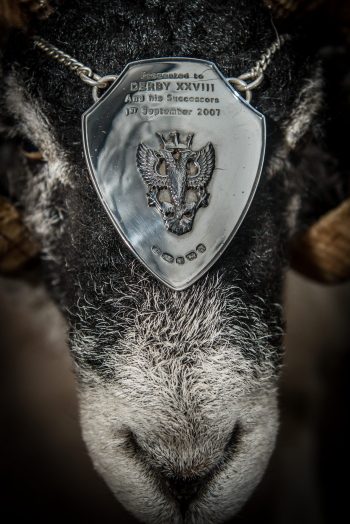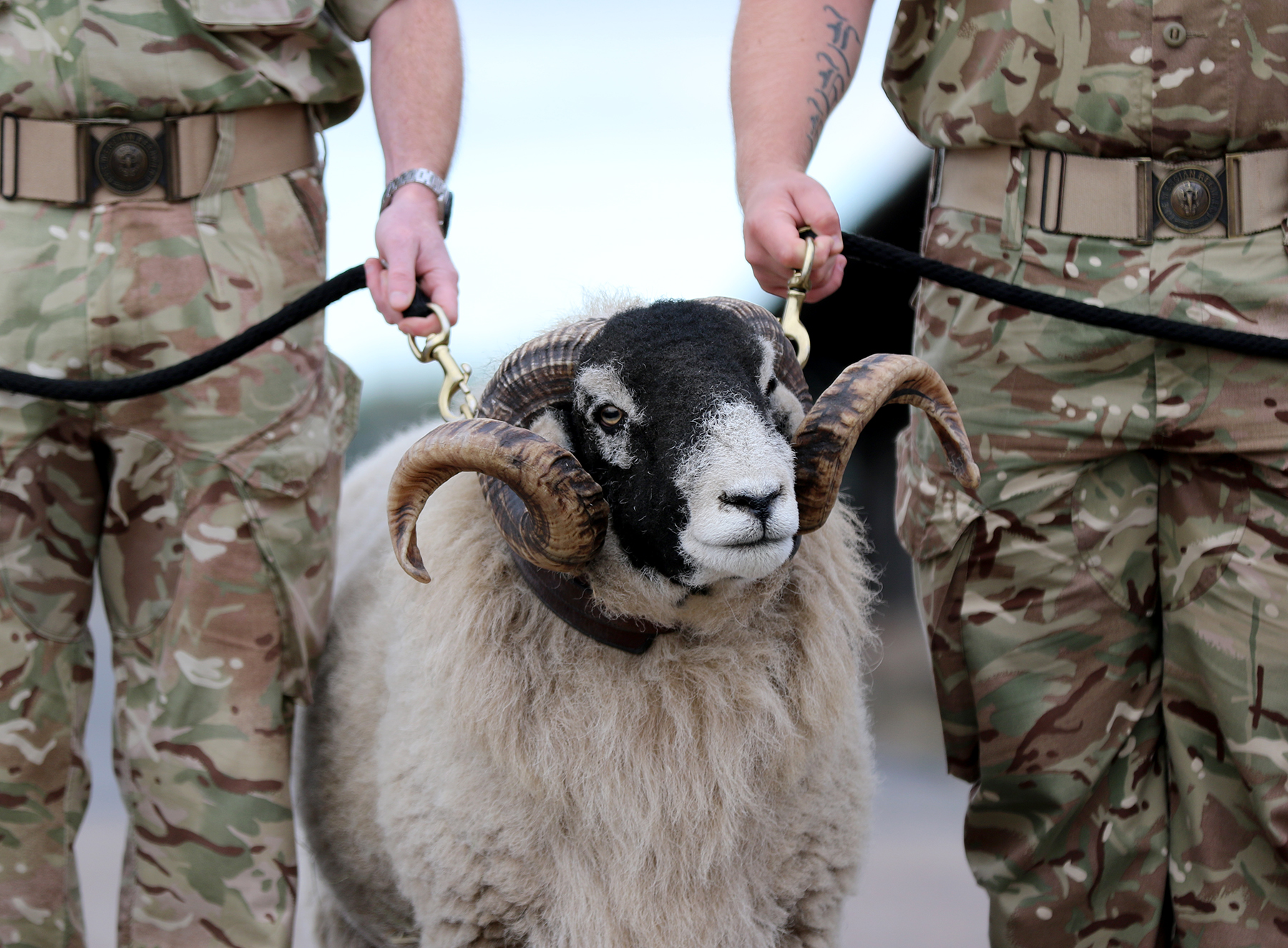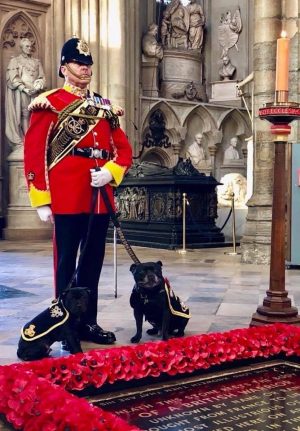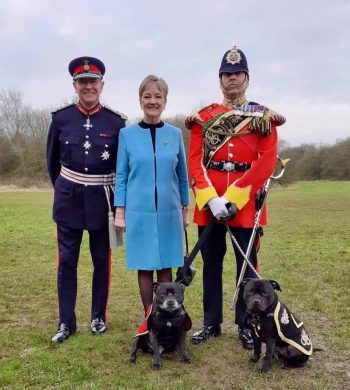The custom of mascots in the British Army goes back to the 18th century and there are both official and unofficial ones. These mascots all have either a connection to their original home County Regiment or will symbolize part of their unit’s history.
The Museum works alongside two mascots. Private Derby is the official mascot of the Mercian Regiment and is one of 7 Official Mascots within the British Army. Watchman was the unofficial mascot of the Staffordshire Regiment and now parades on behalf of the Staffordshire Regiment Veterans Association.
Watchman
In 1884 1st South Staffords were moved from Malta to Egypt where they prepared to march with General Wolseley south to the Sudan to attempt to relieve General Gordon who was besieged in Khartoum. They left at Cairo with their Staffordshire Bull Terrier “Boxer,” unfortunately Boxer leapt from the moving train and was seen lying unconscious at the side of the track.
A few days later when the Regiment camped at Assiut awaiting orders for the final phase of their march, a very thin and bedraggled dog staggered into their camp and collapsed. Boxer had walked for over 200 miles along the scorching desert railway track to rejoin his regiment, a true soldier.
From then on the tradition of having a Bull Terrier as a mascot and regimental pet continued with the battalions. After the Second World War the Watchman tradition, as we now know it, began with the presentation of Watchman I to 6th Battalion of the North Staffordshire Regiment in 1949.
Watchman I was presented to the 6th Battalion the North Staffordshire Regiment, in 1949, for being the highest recruited infantry battalion in the Territorial Army. He accompanied them to the Royal Tournament in Olympia on 25th May 1949. Watchman I, who was a white English bull terrier, showed little interest in the occasion until the band and drums struck up. At which point he raised his head and marched proudly to the thunderous applause of an appreciative audience who had immediately taken him to their hearts.
Over the next decade Watchman I attended every parade in which the 6th Battalion took part and was presented to Her Majesty the Queen on her visit to Burton-on-Trent on 28th March 1957. He passed away in 1959 and was laid to rest in the lawns opposite the Town Hall in King Edward Square Burton Upon Trent. All Watchman’d since this time have been laid to rest alongside him with full military honours.
Watchman 1 had impressed the people of Burton and upon his passing a new custom began. Future Watchmans would be donated to the Regiment by the town of Burton Upon Trent. Each new recruit would be a black Staffordshire Bull Terrier.
Since then there have been six dogs. The current Watchman VI took over duties from Watchman V on 5th March 2019. He was promoted to Lance Corporal on 5th March 2020 st Swynnerton Training Camp.
The Watchman mascot was never made official by the British Army, despite efforts being made on his behalf. When the Mercian Regiment was formed in 2007 he was moved across in support of the Staffordshire Regimental Association. To maintain regimental links Watchman still appears at parades and official events on behalf of the Mercian Regiment alongside their official mascot Pte Derby.
Private Derby
The Mercian Regimental Mascot, a Swaledale Ram, is known as ‘Private Derby’ and is held on the official strength of the Regiment.
On 27th March 1858, Major General Roberts and 600 men of the 95th (Derbyshire) Regiment, with two 9-pounder guns, arrived at Kohtah in central India, where the troops of Raj Ram Singh of Kohtah had mutinied against him and were besieging him in Kohtah’s citadel. Major General Roberts divided his assaulting forces in to three columns.
The third column was to be commanded by Lieutenant Colonel Raines, Commanding Officer of the 95th. In the column he had the 600 men of the 95th, now commanded by Major Eyre Massey, and 600 men of the 10th Native Infantry Regiment.


On the morning of the 30th March, the three columns of infantry crossed the river outside Kohtah by boats and on rafts made from arrack barrels lashed together. The combined troops stormed the rebel held city capturing 50 guns and therefore putting the Raj Ram Singh of Kohtah back in power. During the aftermath of the battle Private Sullivan, of Number 1 Company, found a fine fighting ram tethered in a temple yard. On showing it to the Commanding Officer, Lt Col Raines decided to keep the animal as a mascot for the Regiment.
The ram, now named ‘Private Derby’, marched nearly 3,000 miles with the 95th Foot throughout Central India and was present at six actions during the remainder of the Indian Rebellion (India Mutiny). In recognition of his service Derby I received the Indian Mutiny Medal in 1862 at Poona. Sadly, Derby I died in Hyderbad, India in 1863. The Regiment adopted a new ram to continue the tradition and he was named Derby II. The 95th Foot remained in India until 1870, after which they returned to England before becoming the 2nd Battalion of the newly formed Sherwood Foresters in 1881.
Since that time there has followed a succession of fine rams, each of which has inherited the official title of ‘Private Derby’ followed by his successive number. Some, such as Derby XXIX, have even have managed to achieve the rank of Lance Corporal. Replacement rams were initially presented to the Regiment in whichever part of the world they were serving at the time, but since 1912 the Duke of Devonshire has selected a Swaledale Ram from his Chatsworth estate flock and presented it to the Regiment. There have been the odd departure from the tradition, with Derby XIV and XV presented to the Regiment by His Highness the Bahadur of Kotah in 1924 and 1930 respectively.
When the Mercian Regiment was formed in 2007 Pte Derby became their Mascot. To stay linked in with his original traditions he now sits on the strength of the 1st Battalion of the Mercian Regiment.


